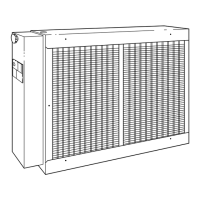g. Fill wash container with clean, hot water and soak cell(s)
for 5 to 15 minutes.
h. Remove cell(s) and let water drain. If water draining
from them feels slippery, detergent still remains. Repeat
rinsing until water from them no longer feels slippery.
Inspect for cleanliness.
i. When both cells have been washed and thoroughly
rinsed, check cells for broken wires and bent collector
plates. If none are found, replace electronic cells and
pre-filter in cabinet. Observe proper airflow arrows on
cabinet and cells.
j. Dry cells completely before turning on power to air
cleaner. This can be done by turning on system fan
continuously for approximately 30 minutes before turn-
ing on power to air cleaner.
SERVICE GUIDE
CAUTION: Procedures in this section should be per-
formed only by qualified service personnel.
WARNING: Electrical shock can cause injury or death.
1. During troubleshooting procedures, dangerous line-voltage
circuits are exposed. Use care to avoid hazard of electrical
shock or damage to equipment.
2. Although not lethal, high-voltage output of power supply
can produce painful shock.
3. Be sure to properly ground air cleaner and its components
before testing.
4. Do not touch any portion of air cleaner when energized.
A. Tools and Equipment
Servicing the EAC can be accomplished with only a few tools:
1. Screwdrivers: Long shank, plastic or rubber handles (2
required).
2. Needle nose pliers for stringing ionizing wires.
3. High-voltage jumper cord.
4. High-voltage tester: range to 12 KVDC (DC voltage probe
recommended).
5. Grounding wire.
I. ELECTRICAL TROUBLESHOOTING GUIDE
The following troubleshooting procedure is a simplified approach
to aid service personnel in repairing any malfunction in the EAC.
By following this troubleshooting procedure and the operation
light, the malfunction can be isolated to certain areas in the EAC.
A. Normal Operation
For normal operation of an EAC, the system blower should be
running and the air cleaner switch should be ON. This will allow
the unit to be energized and cause the light on the power door to
glow. Occasional arcing by an EAC is normal (the light on the
power door will flicker). This can result when lint or large particles
of dirt are not stopped by the pre-filters. The dirtier the EAC
becomes, the more likely occasional arcing will occur. Continuous
arcing may indicate cleaning is necessary. The EAC should
operate only when the system blower is running.
B. Isolating Malfunctions
Switch on the EAC and energize the blower system. If the light
does not glow, remove the cells and replace the door. If the light
glows with the cells removed, the problem is within the cell or
cabinet. Proceed to items 1 through 3. However, if the light does
not glow, proceed to items 4 through 10.
It may be necessary to perform items 1 through 3 after completing
items 4 through 10.
1. Check spring on cell to see if it is bent, sprung, or deformed.
Check to see that it makes good contact with door. If not,
repair or replace.
2. Check male and female plug and receptacle and associated
wire connection on power door and cabinet for damage and
proper wiring.
3. Visually inspect air cleaner cells, visually inspecting for:
a. Heavy dirt accumulation (Wash cells—see Cleaning The
Cell section.)
b. Bent collector plates. Straighten, if necessary.
c. Ionizer springs broken or bent. Replace if necessary.
Check to see that ionizer springs are seated properly in
place. Improper seating may cause arcing.
d. Insulators cracked or broken. Replace if necessary.
Deterioration of metal around insulator indicates defec-
tive insulator (Replace insulator).
e. Ionizer grid deformed. Repair or replace as necessary.
Check for short between high-voltage contact (found in
center of rectangular ceramic insulator) and frame of
cell, with ohmmeter. Resistance should be infinite (open
circuit). If the light does not glow when cells are
removed:
4. Remove power door from unit and check for power to air
cleaner cabinet. This can be accomplished with a volt meter.
Being careful to avoid electrical shock, check output at the
receptacle with volt meter. Reading should be approxi-
mately 120v (240 for 240-v conversions).
During normal operation, power to the cabinet should only be
activated while system blower is operating. To avoid building up
an undesirable concentration of ozone DO NOT operate EAC
when blower is off.
5. Disconnect power and remove access panel on power door
and visually check to see that all wire connectors are firm
and that wires are not broken. Repair or replace with 18
gage wire minimum.
6. Inspect ceramic insulators for dirt or damage. Clean or
replace. Deterioration of metal around insulator indicates
defective insulator. Replace, as necessary.
Inspect for visual damage.
Fig. 25—Checking 120-V Power Pack
A91478
—11—

